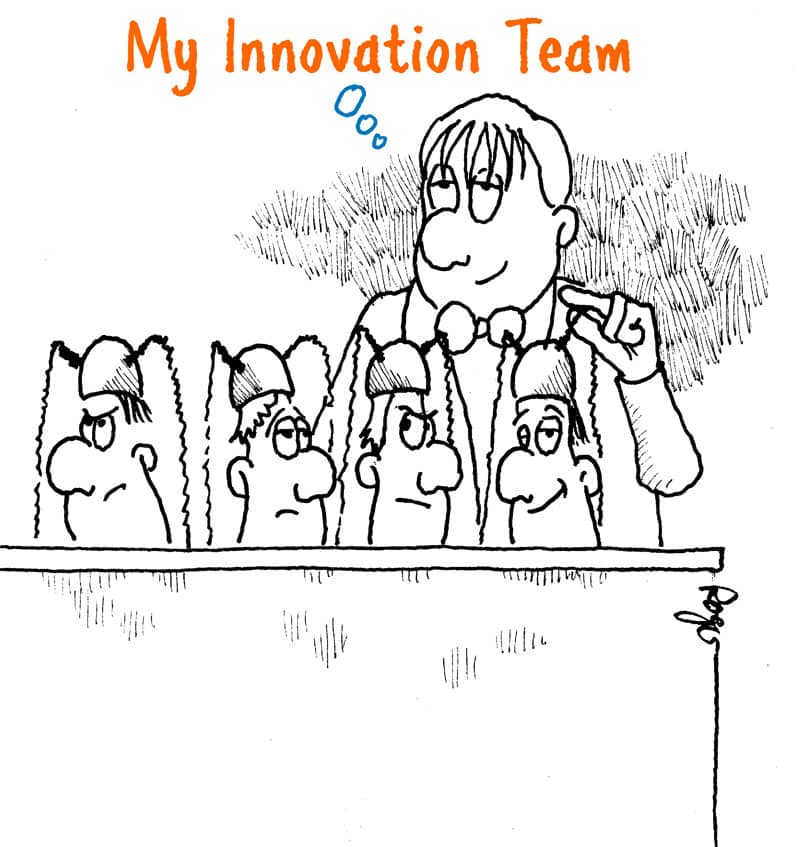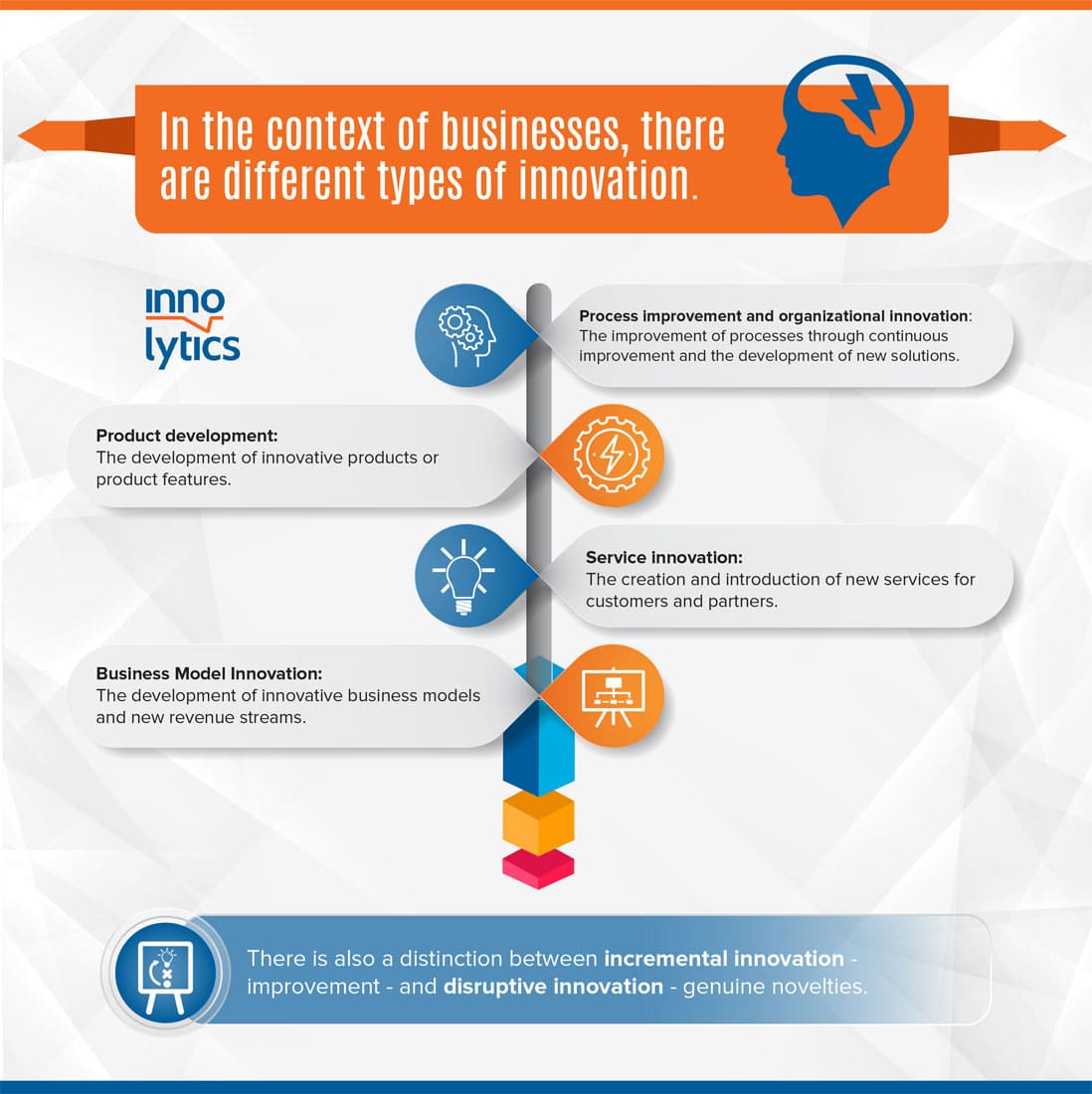Which Best Supports Innovation in the Safe House of Lean
Innovation is one of the most of import topics concerning the long-term competitiveness of companies.Simply what is innovation exactly? Why isinnovation management and so important for organizations? And whatunlike types of innovation are there? In this article, you will become aneasy-to-understand introduction to a complex topic.
- What is Innovation? (Definition)
- Why is innovation so important?
- The Right Mindset for Innovation
- The Different Types of Innovation
- Managing Incremental and Confusing Innovation
- How to Establish an Innovation Culture
What is Innovation? (Definition)
The word "innovation" is derived from the Latin verb innovare, which means to renew. In essence, the word has retained its pregnant up until today. Innovation means to improve or to replace something, for example, a process, a product, or a service. In the context of companies, still, the term needs a definition. In the circuitous context of business concern, a definition is needed.
Innovation is a process past which a domain, a product, or a service is renewed and brought upwards to appointment by applying new processes, introducing new techniques, or establishing successful ideas to create new value.
The creation of value is a defining characteristic of innovation.
Why is innovation and then important?
Organizations have several options to increase their competitiveness: they can strive for price leadership or develop a strategy of differentiation. In both cases, innovation is essential.
- Companies that choose toll leadership must secure their long-term competitiveness by developing innovative, highly efficient processes. Process optimization and continuous improvement in terms of costs are important for them.
- Companies that strive for a differentiation strategy demand innovation to develop unique distinguishing features to their competitors.
- Many kickoff-ups launch their activities by developing an innovative product or service.
Continuous innovation is, therefore, crucial for all companies. The main difference is in the focus of the innovation strategy, which varies considerably from company to company.
The Right Mindset for Innovation
Innovation requires more than creativity and more willingness to take risks than the implementation of typical projects. To successfully realize innovation projects, a unlike mindset is needed. Nosotros take created four cartoons, which you lot are welcome to include in presentations or on your website with reference (backlink) to this page.

Break the rules!
With traditional approaches and conventional methods, yous will oft not go anywhere in the field of innovation. Challenge the status quo consistently! And explore new paths off the beaten rails.

Collect ideas everywhere!
Innovation projects constantly need new ideas: To overcome obstacles, to change concepts, and to optimize strategies.

Believe in the impossible!
Imagine how your innovation will look like in reality. And believe that you will be able to overcome all obstacles on the fashion to realization.

Put together an innovation team of individuals with different perspectives and thinking styles!
Innovation needs the diversity of various competencies and diverse ways of thinking.
The Different Types of Innovation

Many Companies Focus on Incremental Innovation
At that place are different degrees of innovation. The mere improvement – for example, of processes or products – is chosen incremental innovation. Major innovations that lead to substantial changes are called disruptive innovation or radical innovation.
- Incremental innovations are, for example, the optimization of existing processes and procedures or a product line extension.
- Confusing Innovations are, for example, major innovations such every bit iTunes and Google Android. These are often referred to every bit "digital disruption": Innovations that change the logic of existing markets.
The Difference Betwixt Incremental and Disruptive Innovation
For many companies, innovation means taking existing products and changing details: The color, the grade, the functionalities, the size, etc.
- This course of incremental innovation ensures the competitiveness of companies in existing markets.
- In future markets, incremental innovation is oftentimes no longer sufficient. Companies must radically reinvent products and services.
To ensure their long-term innovation capability, companies worldwide have established an idea management and innovation direction organization that provides a structured approach: From the evolution of an innovation strategy to setting up an innovation roadmap and successfully implementing innovation.
Managing Incremental and Disruptive Innovation
For companies, setting up an innovation management is important in gild to go along pace with irresolute customer needs.
Incremental innovation provides competitive advantages in terms of production costs, functionalities, or equipment.
- Conventional innovation management often does non go beyond incremental innovation: products are improved, only not reinvented.
- With methodologies like the Stage-Gate Model for the innovation of process and production evolution, however, companies quickly accomplish their boundaries, – especially in supersaturated markets.
Particularly in times of digital change, in which new customer needs emerge, companies must be able to develop more far-reaching forms of innovation and bring them to market place successfully.
Confusing Innovation Needs Different Approaches
Companies that desire to drive disruptive innovation forwards need to take a different approach and pursue a revolutionary path in addition to traditional methods.
- More and more businesses realize that different approaches are critical to long-term growth.
- Innovation has to be more radical in the future.
- This requires rethinking. New management techniques are existence sought. More courage and willingness to take risks are necessary.
The consequence of such management approaches are new products and services for tomorrow's markets. Business models that are yet impossible to imagine today will sally. Small teams that can human action flexibly develop innovative concepts faster to marketplace maturity.
Methods for Managing Innovation
How to Establish an Innovation Civilization
The implementation of innovation processes and an innovation culture tin exist supported past appropriate software tools. The Internet offers new possibilities for communication and collaboration. For example, innovation teams can create workspaces for unlike innovation projects, jointly develop ideas and make them ready for implementation. Innovation tools besides ensure that an innovation culture is created in the company and that barriers to creativity and innovation are overcome. Past establishing the correct civilisation, employees perceive innovations every bit positive changes and back up innovation with motivation and enthusiasm.
Source: https://innolytics-innovation.com/what-is-innovation/

0 Response to "Which Best Supports Innovation in the Safe House of Lean"
Enviar um comentário